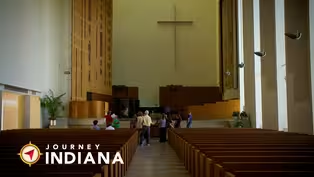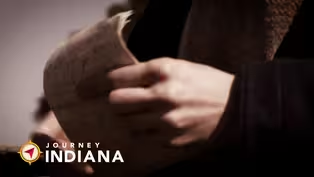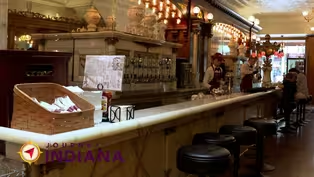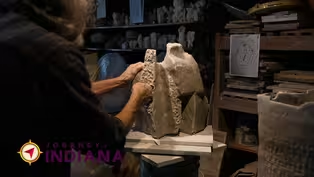Journey Indiana
Columbus
Season 7 Episode 2 | 26m 46sVideo has Closed Captions
Columbus architecture, a craft clay artist, a Civil War hero, and Zaharakos Ice Cream Parlor.
Come along as we explore Columbus, Indiana. Tour the city's world-class architecture, meet a sculptor creating metal sculptures out of clay, learn how one soldier turned the tide of the Civil War, and check out the iconic Zaharakos Ice Cream Parlor.
Problems playing video? | Closed Captioning Feedback
Problems playing video? | Closed Captioning Feedback
Journey Indiana is a local public television program presented by WTIU PBS
Journey Indiana
Columbus
Season 7 Episode 2 | 26m 46sVideo has Closed Captions
Come along as we explore Columbus, Indiana. Tour the city's world-class architecture, meet a sculptor creating metal sculptures out of clay, learn how one soldier turned the tide of the Civil War, and check out the iconic Zaharakos Ice Cream Parlor.
Problems playing video? | Closed Captioning Feedback
How to Watch Journey Indiana
Journey Indiana is available to stream on pbs.org and the free PBS App, available on iPhone, Apple TV, Android TV, Android smartphones, Amazon Fire TV, Amazon Fire Tablet, Roku, Samsung Smart TV, and Vizio.
Providing Support for PBS.org
Learn Moreabout PBS online sponsorship>> Funding for "Journey Indiana" was provided in part by: The WTIU Vehicle Donation Program.
Proceeds from accepted donations of a car, or other vehicle, make this program possible.
Most vehicles are accepted and pickup can be arranged at no cost.
Learn more at WTIU.org/support.
>> Charitable IRA rollover gifts, individuals aged 70 and a half or older may make a tax-free charitable distribution from their IRA to WTIU.
Consult your advisor and visit Indianapublicmedia.org/support for more details.
>> WTIU sustaining members, committing to regular monthly contributions, providing WFIU and WTIU with reliable ongoing support.
Becoming a sustainer is one of the most effective ways to support public media.
>> And by viewers like you.
Thank you!
♪ >> Today on "Journey Indiana," we're exploring stories from the wonderful city of Columbus.
Tour the city's one-of-a-kind architecture.
>> It is unique and remarkable, really, that we have over 70 significant buildings and landscapes in this town of 50,000 or so.
>> Meet a sculptor with an uncanny style.
>> I wouldn't recommend other people to go out and try to make 10-foot pieces of clay sculpture, but it's worked for me.
>> Learn about a local man who turned the tide of the American Civil War.
>> Barton Mitchell is a reminder that the small contributions of everyday Hoosiers made a big difference in the tide of the Civil War.
>> And explore a Columbus culinary landmark.
>> I would venture to say, you will not find another ice cream parlor like this in the world probably.
>> That's coming up on this episode of "Journey Indiana."
♪ >> First up, let's check in with the Columbus Area Visitors Center and get a better look at some of the many architectural wonders that Columbus has to offer.
♪ Believe it or not, tiny Columbus, Indiana, in south central Bartholomew County, is considered one of the most architecturally significant cities in the United States.
And that's thanks largely to J. Irwin Miller, the former head of the Cummins Engine Company, based right here in Columbus.
In 1954, Miller established the Cummins Foundation, and offered to pay the hefty architectural fees for new public buildings.
That allowed the city to enlist premier architects such as IM Pei, Eero and Eliel Saarinen, Kevin Roche, Harry Weese and others.
Today, visitors can easily glimpse many of the resulting architectural treasures on a Columbus Area Visitors Center walking tour.
>> It is unique and remarkable, really, that we have over 70 significant buildings in this -- and landscapes in this town of 50,000 or so.
>> John Crofts would certianly know.
As an architectural tour guide for the past eight years, he's been around the block, literally.
>> On the walking tour, we'll go past many sites, and probably stop and talk about well over a dozen.
We see a mix of mid-century modern, even some more recent buildings, but then also some of the vernacular buildings, the courthouse, the historic city hall and that.
>> The tours are geared towards tourists and locals alike, ensuring that both gain a better understanding of the city's architecture and history.
>> We have locals that have actually moved here and been here for a while, but have never bothered to take a tour or don't fully understand kind of the back story to why we have all this modern architecture.
>> There are, of course, some locations that stand out more than others.
>> As far as the tours, it seems like the Miller house, the modern house which is now a museum, that seems to be our most popular tour.
We've got a lot of fabulous churches.
So I think those are a draw.
My favorite place is a coffee shop that was in a modern bank branch.
It's just great to be in that space and enjoy time there.
>> The addition doesn't touch the building.
It's connected with a glass atrium.
So IM Pei's vision of the natural lighting and that is all preserved.
>> For John, these tours are a labor of love.
>> I got involved with the visitors center after I retired, 37 years at Cummins.
I'm a mechanical engineer.
So work-wise, this was sort of a change, if you will, for me.
>> It's just the names and the dates.
>> What I enjoy about giving tours is the opportunity to meet people, and, I guess I kind of like to tell stories and talk a lot.
>> I learned that there's a workman's boot hiding on the sculpture.
>> You know, you really feel good if you can answer their questions and give them an appreciation for what they are seeing.
>> And while Columbus may not wow you like other major architectural destinations, Columbus will certainly surprise you.
>> The reason that people might want to visit Columbus and then take a tour is to see what can happen when there's sort of a focus.
It was sort initiated by Irwin Miller, but then the whole community seems to have caught on.
>> Next, meet a local Columbus artist whose unique clay sculptures just might make you do a double take.
♪ >> Just outside of Columbus, artist and retired teacher Robert Pulley has created a world of his own.
These mischievous sculptures are meant to mimic the qualities of cast metal and stone.
>> They are an illusion, the way a painting is an illusion.
When I was a kid, we lived at the edge of town, and I loved hiking along the creeks.
There would be trees growing out of cracks in the bluffs.
You'd climb up into the rocks, and there's this layering of this -- of this sedimentary stone.
So I was interested in stone and sedimentary stone and glacial stone and some -- showing a sense of time, maybe loss.
I just think of that as power and energy.
>> He achieves that sense of power by building these sculptures from many layers of delicate clay.
>> So I like to use the qualities of clay, sometimes to move me in different directions.
Lots of improvisation and sketchbooks.
I have vague ideas of proportion I'm after, or some kind of a formal quality that I'm looking for, and I just do thumbnail sketches.
>> From there, he fleshes out these forms in different materials, sometimes clay, and sometimes Styrofoam.
>> And I can sit there, take my little box in while I'm watching TV and make a big mess.
When I come up with something that I like, I dip it in wax.
And I can leave the wax just as kind of like a unifier.
I'll do a lot of these.
When I'm working on making models, I'll make six or eight times what I might ever actually build.
Part of it is, I just really like clay.
I like when you are stretching this clay and it's opening up.
It's using the same thing as plate tectonic, you know, the way it responds to your touch.
And I like the way I work on multiple pieces over time.
♪ I will just demonstrate how this works a little bit.
I will start with this fatter coil -- or this coil.
I leave it to strengthen this segment I will be building.
>> As his work grew in size, he developed new techniques to bring them to life.
To create these large public scale works, he not only builds them in layers, but also crafts them out of smaller, modular pieces.
>> The blocks are -- the blocks are kind of determined by the sculpture, the structure of the sculpture, but they're also determined by what I think I can handle.
The stoning is -- even though it's an illusion, this is just clay.
I wouldn't recommend that other people go out and try to make 10-foot pieces of clay sculpture, but it's worked for me.
>> Like any good artist, he takes inspiration wherever he finds it, even if it's from one of his students.
>> He had this little vase for me.
It was very nice.
I said, well, you are supposed to have done a play decoration area.
He says, that's okay, Mr.
Pulley.
I'll take care of it.
So he added this texture on the side, that he put on when it was dry.
And I thought, oh, I never thought of working with the clay after it was leather hard.
This texture, I've been using a lot.
I like it as a contrast to the other textures.
It just looks like stone that has been fractured off, and it adds a nice contrast.
>> And while he might have picked up a few tricks from his students, he hopes to have left them with a lifelong love of art.
>> I taught art in various elementary schools for 18 years.
Then I went to the high school for 13 years.
I was wanting them to explore their own ideas and to have a lot of freedom.
My strong point, I think, was just trying to show them what art was as a -- as an exploration.
>> One of the things that drew Pulley to Columbus in the first place was the city's profound commitment to architecture that engages the community.
>> The built world impacts people.
Their environment impacts them, whether they know it or not, and that was what I was thinking was happening in Columbus, that they were going with that assumption, that architecture had power.
There's certainly been people that I've met here that have been important to my life and important to bounce ideas off of and see -- just kind of share the experience.
The best work goes off to shows, and then at some point, they're just displaced by new work, and it settles down out here.
My wife and I have lived on this piece of property for 40 years now.
So the environment you see around us, all the sculpture has been out and come back and rests here.
It's just been a little sanctuary, and it's kind of grown with us.
>> And as his sculpture garden grows, so too does the artist.
Pulley continues to explore new techniques and find the rugged beauty of nature layer by layer in the clay.
>> Now, let's head back in time to learn about a local hero who helped to turn the tide of the American Civil War.
♪ >> Living in Bartholomew County in the 21st century, we may feel very far removed from the Civil War.
However, remembering someone who lived among us in our county and made a small contribution that made a huge difference is something for us to feel that connection.
>> East of Columbus, Indiana, down a hidden country road near Hartsville, is a small cemetery few would even notice.
Here, among many weathered headstones, is the gravesite of Barton Mitchell, a common foot soldier from Indiana, who played a most uncommon role in one of the deadliest battles of the US Civil War.
Some of the earliest photographs in US history were taken of the most significant leaders of the Civil War.
Others were taken of anonymous, everyday front-line soldiers who risked their lives throughout this bloody conflict that helped end slavery and preserve the Union.
Barton Mitchell, a corporal in the 27th Indiana Volunteer Infantry Regiment was one of those individuals.
To date, no definitive photo of Mitchell has surfaced, yet his unlikely discovery helped turn the tide of the war.
>> Barton Mitchell was born in Ohio in 1816.
In 1850, he's listed in the US Census records as living in Warren, Indiana, in Putnam County, and he was also named postmaster of Warren, Indiana, in that year.
[ Explosions ] >> Southern forces attacked Fort Sumter in South Carolina in April 1861, launching the bloodiest war in American history.
When President Lincoln sent out a call to arms, more than 210,000 Hoosiers volunteered to fight for the Union.
Barton Mitchell, a staunch abolitionist, was one of those volunteers.
>> Fire!
>> The 27th was involved in some of the most terrible and deadliest, bloodiest battles in the Civil War.
And in September of 1862, the 27th Indiana was camping in a location outside of Frederick, Maryland, where General Robert E. Lee's Confederate troops had recently been located.
On the morning of September 13th, Barton Mitchell saw something unfamiliar lying in the grass, which ended up being a piece of paper wrapped around two cigars.
Reading the piece of paper, they quickly realized that these were orders from Robert E. Lee detailing his plans for the Maryland campaign for the Confederate Army.
>> The two-page document Mitchell and another soldier discovered was listed as Special Order No.
191.
In it were instructions to each of Lee's field generals for the Confederate Army's push into Maryland and the northern states.
>> He promptly made sure that this piece of paper made its way to General George McClellan's encampment.
>> With Lee's orders in hand, General McClellan was able to maneuver his Union soldiers into position to thwart the attack.
The fight that ensued four days later, what became known as the Battle of Antietam, was the single deadliest day of the entire war.
♪ Some time in the fire ♪ Some time in the fire >> Although the Union suffered devastating casualties on this day, in many ways it was considered a strategic victory because it thwarted Lee's attempt to move further northward at that time.
♪ Some time in the water >> In the weeks just prior to the Battle of Antietam, Confederate President Jefferson Davis had been attempting to gain financial and military support from European countries to help his cause.
After the horror of Antietam, foreign leaders abandoned their support and the confederacy lost a potential source of money and weapons.
The battle also had other repercussions for Lincoln and the Union.
♪ Make me want to kneel and pray ♪ >> The strategic victory was sufficient to give President Abraham Lincoln the confidence to issue the Emancipation Proclamation, which freed the slaves in the Confederate states, and then eventually led to the 13th, 14th and 15th amendments to the US Constitution.
[ Gunfire ] >> Corporal Barton Mitchell suffered a severe calf wound during the Battle of Antietam.
He convalesced in a Philadelphia hospital for months.
Upon his release from the hospital, Mitchell refused to leave the Union Army, despite his injuries.
He served alongside his fellow soldiers during the Battle of Gettysburg.
After the war, he retired and returned to Indiana, settling with his family in Bartholomew County, where he died just four short years later.
♪ >> Barton Mitchell is a reminder that the small contributions of everyday Hoosiers, just like other soldiers with whom he served, made a big difference in the tide of the Civil War.
>> Finally, it's a tasty blast from the past at one of Columbus' most iconic establishments.
♪ >> Zaharakos Ice Cream Parlor has been a Columbus landmark for more than 100 years.
And much of its turn-of-the-century charm remains.
In fact, walking through the front doors feels almost like stepping back in time.
>> Some people come here and they really hope that it's just gonna be fast and everything.
And it's, like, sometimes that's not always the case.
And it's not necessarily a bad thing.
It's just for us, it's -- it's about the experience.
>> This iconic establishment was founded in 1900 by James, Lewis and Pete Zaharako.
The brothers, who had immigrated from Greece, had a knack for the sweets business.
The pioneering trio stood out by introducing modern innovations, such as the liquid carbonic soda fountain and the ice cream cone.
Their business savvy helped the Zaharakos thrive through three generations.
>> Zaharakos was kind of an icon to Columbus, you know, as time went on.
And everybody knew the Greeks and all, what have you.
So we very much became an integral part of the community.
>> But by the turn of the 21st century, the fabled confectionery was failing.
>> Economics played a big part.
The other situation was health.
My sister and my one cousin had serious health problems, and so in a sense we saved the business by selling it.
>> In 2006, the Zaharakos family sold the beloved establishment to Columbus entrepreneur Tony Moravec.
With a profound appreciation for its history, he set out to restore the shop's timeless charm.
>> He saw the potential here, obviously.
It was a matter of just renovating it and carrying it on, you know, because of the tradition.
That's what Zaharakos is about, tradition.
>> Sadly, Tony passed away in 2022.
But thanks to his extraordinary efforts, Zaharakos is still churning out timeless treats, one scoop at a time.
>> Well, it's a secret recipe, but I can let you know a little bit of it.
We use an ice cream mix, but it's not the soft serve.
It's more of, like, an actual ice cream because there is a very big difference between soft serve and what we serve here.
But ice cream base.
All of our flavors have a little bit of vanilla in them.
That's kind of, like, our little secret thing, and it's made here every day.
>> Here at Zaharakos, our most popular sundae is the hot fudge sundae, which consists of hot fudge, topped with vanilla ice cream, whipped cream and then a cherry on top.
>> Another standout feature of Zaharakos is their old-fashioned sodas, made using the restaurant's original marble soda fountains.
>> We are using Seltzer water.
You are adding syrup into it, and then we are hand, like, mixing in your carbonation.
So that way it's real rather than like your auto carbonation to syrup ratio that you would get out of fountain machine.
That's kind of what makes it special and authentic.
>> Our number one soda is definitely the Green River.
>> It's probably close to -- it's a lemon lime, Sprite, Mountain Dew type of a drink.
It's kind of a combination.
So it's pretty good.
>> Yep.
>> In addition to their classic culinary offerings, Zaharakos also offers some one-of-a-kind entertainment.
Over 100 years old, this Welte self-playing organ is one of the last of its kind that still functions.
♪ >> So how the Welte works, it's kind of like the windup piano players that are, like, handheld.
There's sugar scrolls.
They are very delicate.
We wear gloves when we get 'em out.
We have over 132 of them.
We have a lot of "The Entertainer."
That was Tony's favorite.
And so we have six scrolls that are just "The Entertainer," and we play that one probably the most.
>> While the Welte's melodies may enchant you, there are even more treasures to discover.
Upstairs, visitors can step into the Zaharako family's former living space.
>> The apartment was used by the Zaharako family at one point in time.
They did move out of the upstairs.
It's been completely remolded from whenever the Zaharako family was up here.
One room was turned into a bedroom, another was turned into a kitchenette.
There are a lot of details at Zaharakos, the 100 year floor, the soda fountains, the soda bar that we have, and how it's over 100 years old.
I mean, everything is -- it's authentically antique.
>> Whether you are eager to experience the soda fountain era or you're just looking for a tasty treat, Zaharakos is sure to delight.
>> It's an actual working museum of a time that's gone by.
I venture to say, you will not find another ice cream parlor like this in the world probably.
♪ >> We'll leave you today at Lucabe Coffee.
This lovely little shop occupies the former Irwin Union Bank and Trust Building, designed by famed architect Harry Weese.
Thanks for watching.
We'll see you next time on "Journey Indiana."
♪ >> Funding for "Journey Indiana" was provided in part by: >> The WTIU Vehicle Donation Program.
Proceeds from accepted donations of a car, or other vehicle, make this program possible.
Most vehicles are accepted and pickup can be arranged at no cost.
Learn more at WTIU.org/support.
>> Charitable IRA rollover gifts, individuals aged 70 and a half or older may make a tax-free charitable distribution from their IRA to WTIU.
Consult your advisor and visit Indianapublicmedia.org/support for more details.
>> WTIU sustaining members.
Committing to regular monthly contributions, providing WFIU and WTIU with reliable ongoing support.
Becoming a sustainer is one of the most effective ways to support public media.
>> And by viewers like you.
Thank you!
Architec-Tour: Check Out Columbus, Indiana's Architectural Wonderland
Video has Closed Captions
Clip: S7 Ep2 | 3m 52s | Columbus, Indiana is considered one of the most architecturally significant cities in the US. (3m 52s)
Discovering Lee's Lost Orders: How One Indiana Soldier Turned the Tide of the Civil War
Video has Closed Captions
Clip: S7 Ep2 | 6m 9s | Barton Mitchell discovered General Lee's plans for the Battle of Antietam. (6m 9s)
A Timeless Treat: Explore Zaharakos, an Authentic Century-Old Ice Cream Parlor and Soda Fountain
Video has Closed Captions
Clip: S7 Ep2 | 5m 13s | Zaharkos has been a landmark in Columbus Indiana for more than a century. (5m 13s)
Uncanny Clay: Robert Pulley's Mischievous Clay Sculptures
Video has Closed Captions
Clip: S7 Ep2 | 6m 14s | Sculptor Robert Pulley has spent decades creating metal-like clay sculptures. (6m 14s)
Providing Support for PBS.org
Learn Moreabout PBS online sponsorship
- Culture

Celebrate Latino cultural icons Cheech Marin, Rauw Alejandro, Rosie Perez, Gloria Trevi, and more!













Support for PBS provided by:
Journey Indiana is a local public television program presented by WTIU PBS



